이곳에서 해볼 수 있음. http://www.myheritage.co.kr/
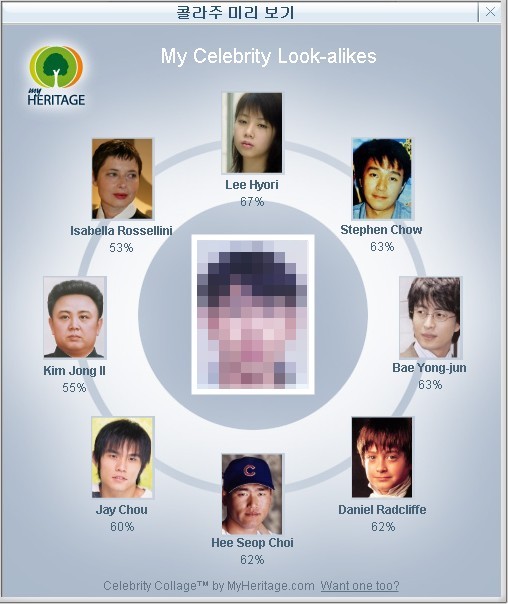
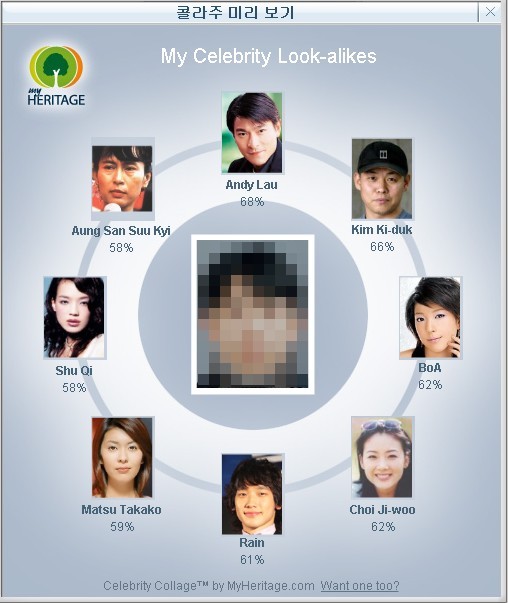
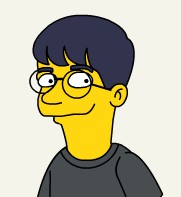
이건 내 사진을 심슨化 시킨 것이다. 여기서 해볼 수 있음. http://simpsonizeme.com/



There is no such thing as the perfect horse...
However, by being knowledgable about the finer points of equine anatomy and conformation, you can find a horse that is more likely to be able to do what you want him to do, without being compromised by his shape and build.
Below is a drawing showing the main points of equine anatomy and conformation, including some of the things I will be discussing.
| Parts of the Horse Art Explosion by Nova |
| A | Muzzle | B | Poll | C | Crest | D | Withers |
| E | Back | F | Loins | G | Croup | H | Dock |
| I | Point of Hock | J | Hock | K | Thigh | L | Stifle |
| M | Chestnut | N | Ergot | O | Coronet | P | Pastern |
| Q | Fetlock | R | Cannon | S | Forearm | T | Point of Elbow |
| U | Shoulder |
Let's start at the front end
The first thing people look at in a horse is the head. Although it has little to do with the actual performance of the horse, except for the points noted below. most people like to see a horse with a refined head, bright, kind eyes, pricked ears and an alert expression.
Old English terms such as fiddle-headed refer to horses with coarse, unrefined features, and roman-nosed refers to a horse with a convex profile such as is found in the draught breeds, as opposed to the concave, or dished, profile of the Arabian and similar breeds.
Horses are not capable of breathing through their mouths, so the size and shape of the nostrils are important to horses in highly aerobic activities, such as race-horses. This is the reason that Thoroughbreds tend to have larger nostrils, with finer cartiledge than, say, a draught horse.
The eyes and ears can give clues to the temparament of the horse, if not his athletic ability. Large, kind-looking eyes, with no white showing and no rolling of the eyeballs, indicates a more tractable demeanour, as do ears that are pricked and alert, rather than pinned back against the horse's head.
Two areas of the head which can have an effect on the performance of the horse are the throat and the poll. The poll is where the skull of the horse fits on to the spine, right behind the ears. Stiffness in this area can cause the horse to have difficulty in softening to the rider's hand and "come on the bit". Likewise, a horse with a thick throat area may have difficulty giving to the rider and may give the rider the feel that he is riding a plank of wood.
The horse's neck should be in proportion to the rest of the body, appearing neither too long nor too short. A gentle arch to the neck is pleasing, without excessive muscling underneath. Stallions are more prone to have more crest along the topline of the neck than either geldings or mares, although the more a horse is worked in certain disciplines, such as dressage, the more the muscle along the topline will be toned up. A horse with thick muscling along the underside of his neck will feel stiff and resistant to ride. This can also be changed with exercises to build the muscle along the top of the neck, encouraging the horse to relax the muscles along the underside.
The term ewe-necked refers to a neck that appears to be put on upside down and a horse with a swan-neck has a very long neck, usually with excessive bend similar to a swan, from which the term is taken. Both of these conformations are considered undesirable.
Equine Anatomy - The Shoulder
The way the neck joins the body can influence the way the horse goes. Some horses, such as the Quarter Horse, have a lower set-on neck than do others, such as the Saddlebred. This predisposes the Quarter Horse to carry his head lower than the Saddlebred, such as is desired in Western Pleasure classes and makes him a natural choice for these classes, Many of the carriage breeds, such as the Cleveland Bay, the Friesian and some of the German Warmbloods (who were originally bred as carriage horses and who now excel in sports such as dressage and showjumping) have a much higher neck, giving them a higher head carriage which lends an air of presence.
The shoulder itself is critical to the horse's way of going. A well sloped shoulder (as measured from the point of shoulder to the withers) will allow the horse to take a long, economical stride, enable him to extend in the trot, gallop easily, will make for a more comfortable ride, and is desirable in the riding horses such as the Thoroughbred, the Quarter Horse, and the Hunter. However, it is not found in all riding horses, and the breeds in which a high-stepping, showy action is required, such as the Andalucian, the Saddlebred, and the Morgan will be more apt to have a more upright shoulder, which places the foreleg more underneath the body and results in less extension of the forelimbs, but more upward knee action.
|
Equine Anatomy - The Body The girth, or barrel, of the horse should be deep, giving the horse plenty of heart room to contain the internal organs. The body should be rounded and the ribs well-sprung. The term slab-sided refers to a horse with a narrow, flat-sided body. The back should be considered to be the most important part of the riding horse. The horse is not naturally a weight carrier, it is more designed by nature to be a weight puller, so it is expecially important to make note of types of conformation that predispose the horse to even greater weakness in the back. First of all, the back should be shaped in such a way as to accept a saddle comfortably and should be neither too long nor too short. A back which dips excessively is called a sway back and which is generally found in older horses, and its opposite, a roach back both can cause difficulties with fitting a saddle. An excessively long back will have inherant weakness which may not stand up to concentrated work, and a very short back will give the rider a bumpy ride as the propulsion of the hind legs will tend to bounce him out of the saddle. The point where the back joins the quarters is called the loin and it is very important that this area is strong and muscular if problems are to be avoided. Horses with long backs are prone to weakness in this area. The croup is the highest point behind the saddle and should be level with the withers in the mature horse (as horses are growing, their growth spurts often make the croup higher than the withers) . In the mature horse, a croup higher than the withers will cause a tendancy to lean on the forehand and be heavy in front. This is not the same as goose-rump or jumper's bump, both terms which refer to a high, well muscled rump usually associated with jumpers. |
Equine Anatomy - The Hooves and Legs The legs could be said to be the most important part of the horse, for if a horse has weakness or bad conformation in his legs, his athletic ability is going to be seriously compromised, no matter what you plan to do with him. From a general standpoint, the legs should appear straight, muscular and sturdy, and capable of carrying the horse. On to Specifics The forearm should be long and muscular and the knee should be large and flat, not round and puffy. The tendons have to pass through the knee to the lower leg and that is why large, flat knees are desireable, to allow the maximum movement. The cannon-bone, the bone in the lower leg, should not be too long. Looking at the horse from the side, the knee should appear low in the leg. If it appears high, it means that the cannon bone is longer than ideal, and prone to weakness. The way the lower leg joins at the knee is important to the functionality of the leg too. In some horses you will see that the lower leg appears tied in below the knee , where the leg is narrower directly underneath the knee than it is further down. This can restrict the movement of the tendons. In some cases the horse may be over at the knee where the lower leg appears set back in comparison with the upper leg. The opposite of this is back at the knee where the knee and upper leg appear set back in comparison with the lower leg. As the horse's ability to carry weight depends on the inter-functioning of all these parts, it is important that they line up correctly, in order to be most efficient. The pastern is the horse's shock absorber, at times carrying the horse's entire weight, plus that of the rider. The ideal pastern is neither too long nor too short, too sloped or too upright. Overly long sloping pasterns will place a strain on the suspensory ligament and the tendons which run down the back of the leg. Pasterns which are too upright do not perform sufficiently well to overcome the concussive effects of movement and so the leg may suffer with soundness problems because of it. |
Equine Anatomy - The horse's hoof
You know the saying "No hoof...no horse", well - never a truer word was spoken. The ideal hoof is well-matched with it's partner in size and shape (hind feet will be bigger and the footprint more oval than the front feet) The horn should be strong and flexible, not weak and shelly or dry and crumbly. (I plan on doing some extensive research and bringing you the latest information and help on how to keep your horse's hooves in tip-top condition). Problems with the hoof walls will mean that the horse will have difficulty holding on shoes (a problem I am all too familiar with). Different breeds of horse tend to have different sized feet. The draught breeds have huge soup-plates of feet whereas the Arabians have small strong-horned feet. When trimming and shoeing the horse it is necessary to maintain the natural size of the foot, not to trim it down to fit the shoe, as this will cause problems with soundness, by compromising the natural shock-absorbing qualities of the hoof.
The feet should point straight forward and the horse be neither pigeon-toed, where the toes point in toward each other, nor toed-out , where the horse appears duck-footed with his toes splayed out.
The feet should have fleshy, well-sprung frogs and should not be boxy and upright, like those of a donkey. Lateral ridges around the hoof wall can indicate previous laminitis or, at the very least, changes in growth rate due to illness or changes in feed etc.
|
Equine Anatomy - The hind legs Looking at the horse from the back, the hind legs should be straight and neither cow-hocked, where the hocks turn in (accompanied by turned out toes) or bow-hocked , where the hocks turn out. From the side, the horse should not be sickle-hocked, where the front edge of the leg appears overly curved or bent. All of these conformations can cause soundness problems by compromising the way the shock absorbing qualities of the hock are supposed to work. Equine Anatomy and Conformation - The whole picture |
| Find this article at: http://www.equisearch.com/horses_care/health/anatomy/conformation062197/index2.aspx |
Dr. Doyle G. Meadows, Professor University of Tennessee
Conformation of the Tennessee Walking Horse is directly related to skeletal structure. It includes the bones and ligaments which bind the bones together to form joints. The skeletal structure provides the framework that gives the body shape and protects the vital organs. The skeleton of the horse will determine the length and slope of shoulder, overall height and length, length of back and all the other things that are related to skeletal design.
Generally, the skeletal structures that receive the most attention are the feet and legs. It is obvious that a horse must have structurally correct legs to be a performance athlete or to provide pleasure to its owner. The manner in which a horse moves is determined by the horse's conformation and skeletal structure. The usefulness of Tennessee Walking Horses depends on their ability to move and perform in an appropriate manner.
Front Legs - Front View
The horse's forelimb bears about 65 percent of the weight of the horse. It is, therefore, extremely important to have straight, structurally correct front legs. Due to the amount of weight on the forelimb, there are more front leg injuries as a result of trauma and concussion. It is important to have proper bone length and angle to achieve proper horse conformation (Figure 2).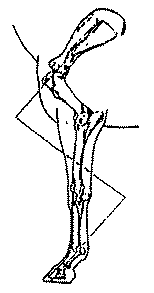
Figure 2. Front column of bones as viewed from the side. Source: Stashak, Ted S. Adams Lameness in Horses. Fourth Edition. 1987.
As viewed from the front, a straight line from the point of the shoulder should bisect the entire front leg all the way to the toe. There should be two equal parts in the ideally structured horse. Although this is actually rare, the toes and knees should point straight forward. Additionally, the width of the toes on the ground should be the same width as their origin in the chest. The cannon bone should be centered on the knee and fetlock (Figure 3).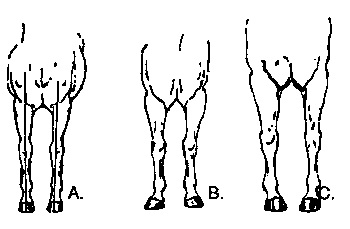
Figure 3. Front leg as viewed from the front: A) Ideal, B)Toes-out (splay footed) C) Toes-in (pigeon toed). Source: Heird, J.C. A Guide for Successful Competitive Horse Judging. Colorado State University, Animal Reproduction and Biotechnology Laboratory. Bulletin No. 07. 1992.
There are several deviations to the ideal front column of bones as viewed from the front. Any deviation from the normal has the potential to affect movement and, subsequently, performance. Horses whose toes point inward (toed-in) are referred to as "pigeon-toed" while horses that have toes that point outward (toes-out) are called "splay-footed" (Figure 3). Foot flight patterns are shown in Figure 4.
tennessee walki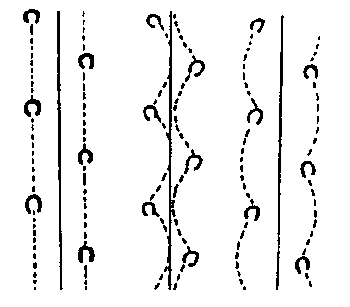
Figure 4. Way of Going: (A)Normal foot moves in a straight line, (B)"Base-wide," or "Toed-out" feet move forward in inward arcs, "Winging", (C)"Base Narrow," or "pigeon toed" feet move forward in wide outward arcs, "Padding." Source: Heird, J.C. A Guide for Successful Competitive Horse Judging. Colorado State University, Animal Reproduction and Biotechnology Laboratory. Bulletin No. 07. 1992.
An additional structural deviation in the front leg is base-narrow (Figure 5). This condition is indicative of a horse whose feet stand closer at the ground than at the origin of the legs in the chest. This is typical of horses with larger muscle mass. The base-narrow horse is predisposed to landing on the outside of the hoof wall. Due to the extra weight placed on the outside of the hoof, horses develop conditions such as ringbone, sidebone and heel bruising. Horses with this conformational problem can either toe-in or toe-out.
tennessee walking horse, tennesse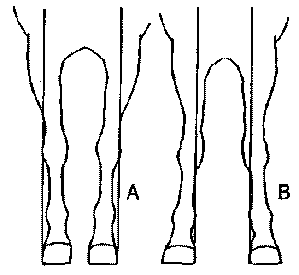
Figure 5. Front leg view: Base narrow. Front leg view: Base wide. Source: Stashak, Ted S. Adams Lameness in Horses. Fourth Edition. 1987.
Base-wide conformation positions the feet of the horse at the ground wider than their origin at the chest (Figure 5). This condition is seen in many narrow-chested horses and is usually accompanied by feet that toe-out. Unlike the base-narrow horse, this condition allows more weight to be distributed to the inside of the horse's hoof. Horses that are base-wide are also predisposed to ringbone and sidebone.
Bowlegs, knock-knees and bench knees are examples of poor conformation that may affect soundness (Figure 6).
tennessee walking horse, tennes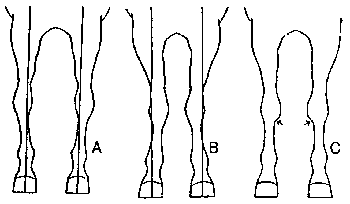
Figure 6. Front leg structural faults: A)Bowlegs, B)Knock-knees, C)Bench knees. Source: Stashak, Ted S. Adams Lameness in Horses. Fourth Edition. 1987
Bowlegged horses present the entire knee in an outward deviation as viewed from the front. This condition causes increased tension on the outside of the leg due to the unequal distribution of concussion and force. Knock-kneed or close-kneed horses have the entire knee set to the inside of a straight line from chest to toe. This condition is generally accompanied by horses being toed-out and with some degree of outward rotation of the cannon and fetlock. Again, this condition is predisposed to unsoundness due to an unequal line of concussion.
Bench knees are another structural fault in horses. Bench or offset knees are characteristic of a horse with the cannon bones set too far to the outside of the knee. This conformational problem increases the possibility for horses to develop splints (Figure 7).
tennessee walking horse, tennessee walking horse, 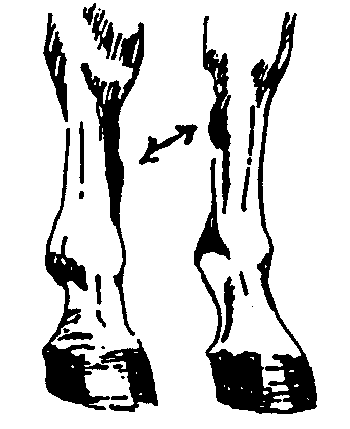
Figure 7. Splints are bony enlargements in the groove formed by the splint and cannon bone. They may be high or low, forward or back.
Front Legs - Side View
The front column of bones as viewed from the side should have appropriate slope and angle of shoulder and pastern. Additionally, a vertical line should run from the center of the scapula to the front edge of the knee and bisect the hoof as shown in Figure 8.
tennessee walking horse, tennessee walking horse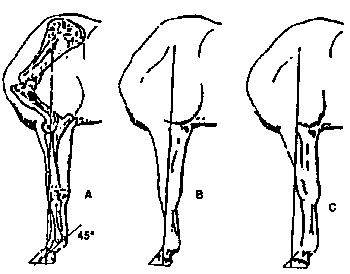
Figure 8. The front legs, side view: A)Ideal, B)Buck-kneed, C)Calf-kneed. Source: Stashak, Ted S. Adams Lameness in Horses. Fourth Edition. 1987.
Some horses are camped-under in front. This condition refers to a horse whose forelimb is too far under the body (Figure 9). This camped-under effect will prevent a horse from having a long fluid stride and predisposes horses to unsoundnesses. These horses typically have excessive wear on the hoof with an increase in pressure on ligaments and tendons.
tennessee walking horse, tennessee walking horse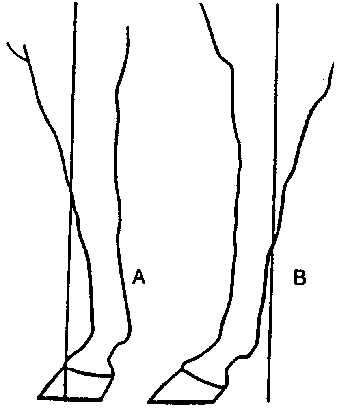
Figure 9. Front leg as viewed from the side: A)Camped-under, B)Camped out. Source: Stashak, Ted S. Adams Lameness in Horses. Fourth Edition. 1987.
Camped-out refers to horses whose entire forelimb is too far forward and away from the body (Figure 9). These horses will have excessive concussion and stress on the knees, ankle and hoof. These horses are predisposed to navicular disease and laminitis. Ideal position of the front leg in relationship to the body is shown in Figure 8.
Two primary structural deviations exist in the knees of as horses as they are viewed from the side. The most frequent condition is "over at the knees" or commonly referred to as buck-kneed (Figure 8). This is a forward deviation of the knee set too far forward in the horse's leg. Although a structural deviation from the normal, buck-kneed horses are capable of a long performance life.
The opposite condition to buck-knees is "back at the knees" or calf kneed (Figure 8). This conformation fault is extremely serious and many calf-kneed horses do not stay sound. This condition positions knees that are set behind or back in the horse's leg. Calf-knees allow the knees to bend backwards (hyperextend) and predispose the horse to unsoundness.
tennessee walker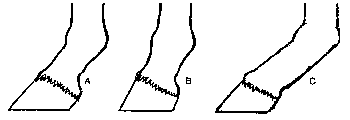
Figure 10. Pastern conformation: A)Ideal, B)Short and steep, C)Long and weak.
Ideal pastern conformation places the angle of the pastern at approximately 45 degrees in front and approximately 50 degrees in the rear pastern, with a moderate length to the pastern (Figure 10). Short, steep pasterns will not allow for the normal "cushion" effect on the forelimb that is found in the ideal. This condition gives a choppy, rough stride that is predisposed to lameness due to extra concussion on the entire front column of bones. Long, weak pasterns allow the horse to injure ankles, tendons and ligaments because the pasterns are too long relative to length of limb.
Rear Legs - Rear View
Ideally, when viewing a horse from the rear for structural correctness, you should draw an imaginary line from the point of the buttocks to the ground which should bisect the gaskin, hock and hoof (Figure 11). This will provide equal distribution of weight, equal bone pressure and equal strain on ligaments. It is not critical that a horse be perfectly straight from the ankles down as viewed from the rear. In fact, most horses naturally stand with the cannons parallel and toe out slightly from the ankles down. This allows a horse's stifle to clear the rib cage in flight, resulting in a longer-strided, freer-moving horse.
tennessee walking horse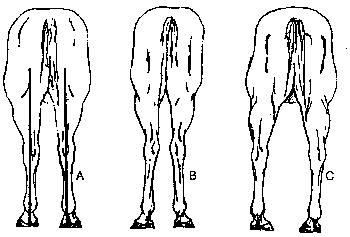
Figure 11. Structure of the hind limb as viewed from the rear: A)Ideal, B)Cow-hocked, C)Bow-legged. Source: Heird, J.C. A Guide for Successful Competitive Horse Judging. Colorado State University, Animal Reproduction and Biotechnology Laboratory. Bulletin No. 07. 1992.
Horses that are bowed-in at the hocks, with the cannon bones not parallel, are referred to as "cow-hocked" (Figure 11). Typically, these horses have hocks that are too close, point toward one another and the feet are widely separated. These horses have hind limbs that are base-narrow from the buttocks to the hocks and base-wide from the hocks to the toes. The horse that is "cow-hocked" will have a tendency to be weak in the major movements that require work off the haunches such as stopping, turning and sliding.
Occasionally there are horses that actually toe-in behind and are "out at the hock" (bow-legged). Bow-legged horses (Figure 11) have hocks that are too far apart and are generally predisposed to being base-narrow. These horses have added strain on the bones, ligaments and joints and may have many types of interference in movement. Most of these horses are very poor athletes and should be severely penalized.
Rear Legs - Side View
Conformation excellence of the horse's hind leg structure as viewed from the side is indicated by a line from the point of the buttocks to the ground. Ideally, that line should touch the hocks, run parallel to the cannon and be slightly behind the heel (Figure 12). A horse with too much angle in the hock joint is sickle-hocked. As viewed from the side, the horse is standing under from the hock down, due to the excessive angulation in the hock (Figure 12). Horses with sickle hocks are predisposed to curbs, enlargements below the point of the hock. Many of these horses tend to be outstanding athletes for a brief period of time.
tennessee walking horse, tennessee walker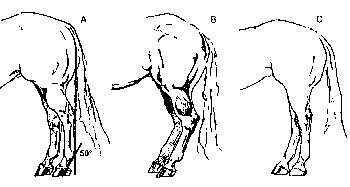
Figure 12. Structure of the hind limb as viewed from the side: A)Ideal, B)Sickle-hocked, C)Post-legged. Source: Heird, J.C. A Guide for Successful Competitive Horse Judging. Colorado State University, Animal Reproduction and Biotechnology Laboratory. Bulletin No. 07. 1992.
Excessively straight-hocked horses have correspondingly less set (or angle) in the hock joint (Figure 12) and are referred to as post-legged. These horses typically have poor movement, with little flexion, which causes limited drive and impulsion from their hind leg. This predisposes the horse to bog spavins, inflammation or swelling of the soft tissue of the hock, and increases the chance for injury and unsoundness.
Summary
Structural correctness ultimately determines the value and usefulness of a horse. Regardless of whether the horse is a favorite at the Celebration or a youth's pleasure mount, length and angle of the bone structure combined with skeletal correctness play a critical role in the usefulness of the athlete. As the number and severity of structural problems increase, the expected life, activity and performance of the horse are severely limited.
References:Stashak, Ted S. Adams Lameness in Horses. Fourth Edition. 1987.
Heird, J.C. A Guide for Successful Competitive Horse Judging. Colorado State University, Animal Reproduction and Biotechnology Laboratory. 1992.
http://www.legacyspottedwalkers.com/TWH_STRUCTURE.htm